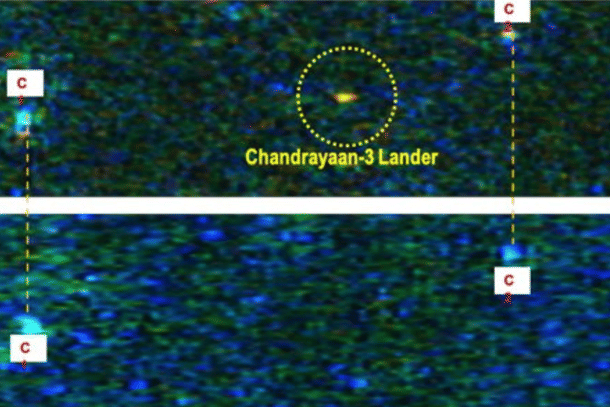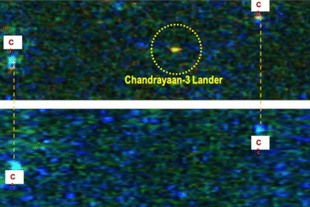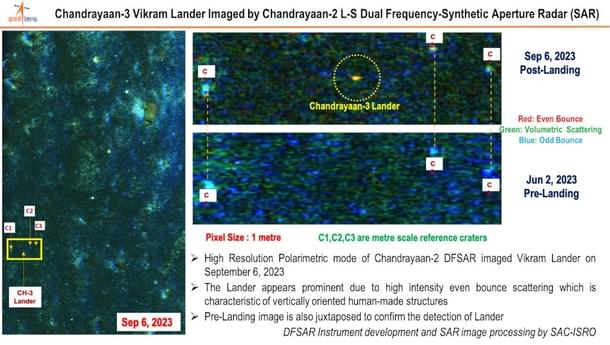Science
Chandrayaan-3: Key Radar Instrument On Chandrayaan-2 Orbiter Images Vikram Lander
Karan Kamble
Sep 09, 2023, 06:10 PM | Updated 06:18 PM IST
Save & read from anywhere!
Bookmark stories for easy access on any device or the Swarajya app.


The Vikram lander is seen in yet another new look, thanks to imaging by a key instrument on board the Chandrayaan-2 orbiter which doesn't need the light of the Sun to take a picture.
This new capture during the lunar night comes just days after the Indian Space Research Organisation (ISRO) shared a unique "anaglyph" image of the lander that provides a 3D feel with the use of the right lenses.
The dual-frequency synthetic aperture radar (DFSAR) instrument on India's lunar orbiter, operational since 2019, imaged the Chandrayaan-3 lander on Wednesday (6 September).
A powerful remote sensing tool, a synthetic aperture radar (SAR) is a way of creating an image using radio waves.
It works by bouncing microwave radar signals off an object, such as the surface of the Earth or Moon, to obtain information about the distance and physical characteristics of a target area.
"A SAR instrument transmits microwaves in a given frequency band and receives the same, scattered from the surface," ISRO said.
Within radio frequencies are categories or "bands" grouped by similar characteristics. The DFSAR employs microwaves in what are called the L and S bands.
Since the DFSAR is a radar, it doesn't require sunlight to take a picture. The Vikram lander was imaged during the lunar night.
According to ISRO, the DFSAR offers "the best resolution polarimetric images currently on any planetary mission."
Thanks to the use of long radar wavelength, the radar instrument has the ability to explore lunar subsurface features down to a few metres.
The DFSAR has been imaging the lunar surface for the last four years, with a primary focus on lunar polar science, and beaming back high-quality data to Earth.

ISRO previously shared a picture of the landing area, including the Vikram lander, taken by the orbiter high-resolution camera (OHRC) on board Chandrayaan-2.
Prior to the historic lunar landing, a two-way communication had been established between the Chandrayaan-2 orbiter and the Chandrayaan-3 lander module.
Karan Kamble writes on science and technology. He occasionally wears the hat of a video anchor for Swarajya's online video programmes.





